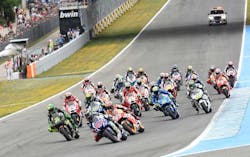Movistar Yamaha MotoGP’s Jorge Lorenzo was in peerless form throughout the Spanish Grand Prix race weekend, culminating in a masterful race victory ahead of Repsol Honda Team’s Marc Marquez and Yamaha stablemate Valentino Rossi who finished in second and third place respectively.
Not only did Lorenzo win the race, he took a clean sweep of accolades including setting a new Circuit Best Lap record in qualifying, a new Circuit Record Lap during the race and completing the race in record time, beating the old mark by twenty seconds.
Conditions were very hot early in the race weekend with the Free Practice sessions and qualifying experiencing track temperatures above 50°C. The high temperatures served to reduce the grip on offer from the already well-worn Jerez tarmac even further. A cool change arrived in time for the race, where the peak track temperature was a milder 40°C which helped the riders set a stunning pace throughout the twenty-seven lap contest.
Q&A with Shinji Aoki – Manager, Bridgestone Motorsport Tire Development Department
The hard compound front tire was used extensively at Jerez, with twenty-three riders selecting this option for the race. What was it about this specification of tire that made it such a popular race choice?
“Jerez is a circuit that requires high levels of stability and feel from the front of the bike. At the same time, the grip level of the tarmac diminishes significantly in hot temperatures so finding the optimal combination of grip and stability is really important for the riders. Our latest specification of hard front slick was designed to offer the same level of stability as the previous spec, but with better grip and this year was the first time riders had access to this new hard front slick at Jerez as we only introduced it into our allocation late last year. I am very happy with how it performed as the riders were able to lap consistently at a very fast pace using this new hard compound front slick, and even in very high temperatures they felt they had good grip and stability from the front-end of the bike.”
Temperatures were considerably cooler in the race than they were for FP4 and qualifying. What effect did this have on tire performance, and did it cause any riders to reconsider their race tire choice?
“The lower temperatures on race day meant that there was more grip on offer from the tarmac, allowing the riders to get maximum performance out of their tires. As a result the pace shown during the race was really impressive. We were confident that we would beat the qualifying and race lap records, as well as the overall race time record this year, but to beat the records with the margins that we did was astounding. With temperatures for the race not as high as they were the day before, it meant the track wasn’t as greasy, so the riders could lap at a strong pace throughout the race. In terms of how the cooler temperatures influenced tire choice for the race, it didn’t have a great effect at all. The majority of riders still used the same tire combinations that they would’ve used in hotter conditions as they were able to assess the performance of the different tire combinations in the cooler morning sessions on Friday and Saturday.”
So, even if track temperatures were just as hot for the race on as they were on Saturday, you don’t think many factory Honda and Yamaha riders would have selected the hard compound rear slick? Why is that?
“The asymmetric hard rear slick we offered this year used the same compounds as 2014, yet it wasn’t as popular as last year, which we believe is mainly due to the deteriorating grip level of the Jerez tarmac. The grip is quite poor in hot conditions, but even in cooler temperatures, the riders felt the grip was worse than last year. Although the hard rear slick was very consistent, the riders needed the rear tire option that offered the highest amount of grip to compensate for the poor track surface to reduce the amount of spinning from the rear. This is what made the medium compound rear the preferred choice for the factory riders, regardless of track temperature. The fact that this option also provided good durability made its appeal even greater at Jerez.”



